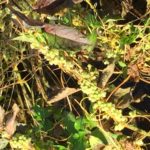Cuscuta spp.
What is Dodder?
Physical Characteristics
Flowers:
- Numerous
- White, pong or yellowish in color
- Small
- 0.08-0.16 inches long
- Can be borne in tight balls or in a loose cluster
Fruit:
- About 1/8th inch in diameter
- Papery thin walls
Seeds:
- 1-4 seeds per fruit
- Yellow to brown/black in color
- Rough surface
- One round & two flat sides
- Seeds grow if host is present
- If no host present, seeds remain dormant for up to 5 years
Stem:
- Twining
- Yellow, orange or green in color
- Sometimes tinged with purple or red
- Thin
- Thread-like
- Relatively stout
- Grow upward until it reaches its host
- Coils around the stem of the host
- If food source is present, secondary root-like branches form
- Once root-like branches form, the base shrivels, so there is no soil connection
Other names include love vine, strangleweed, devil’s-guts, goldthread, pull-down, devil’s-ringlet, hellbine, devil’s-hair, and hailweed.
Where Does it Grow?
USDA, NRCS. The PLANTS Database (http://plants.usda.gov). National Plant Data Team, Greensboro, NC 27401-4901 USA.
Dodder it can be found growing on other plants.
Is it Invasive?
Although some species of dodder are native, it can be a very aggressive invader. Dodder grows as a parasite on various kinds of wild and cultivated plants, and is especially destructive to alfalfa, lespedeza, flax, clover and potatoes.
Pros and Cons of Dodder
Dodder is a parasitic plant, and the seeds are difficult to remove from desired crop seed.




